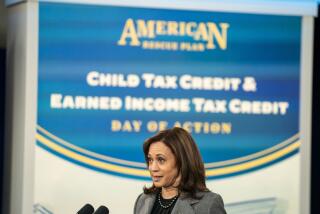Low pay. Fewer leadership roles. Black and Latina child-care workers deal with racial barriers

- Share via
LaWanda Wesley had been working in child care for more than two decades, but no matter what she did, she couldn’t seem to get a meaningful raise or the promotion she felt she deserved. Her salary was stuck at around $19 an hour.
She earned her master’s degree in educational leadership and policy studies, then a doctorate in educational leadership and management — all while raising five children as a single mother. But the organizations she worked for told her not to expect any pay difference or title change. At one point, Wesley, who is Black, was demoted and asked to train a white co-worker to be her supervisor. At another, a company was audited by the state and required to give her a 7% raise because she was so underpaid.
“The message I got as a Black woman in early education was that no matter what you do — what letters and degree attainment — this is your place. And this place is not one of value,” said Wesley. “I remember feeling so less than, so demeaned and confused.”
Women of color make up nearly two-thirds of the early childhood workforce in California, yet they routinely earn lower wages and hold lower positions than their white peers — even when they have more education, according to a new report from the Center for the Study of Child Care Employment at UC Berkeley.
The researchers surveyed 7,500 individuals working in the child-care sector in late 2020 and found:
- Black and Latina educators are more likely to be employed in lower-paying roles.
- Black educators are not rewarded with pay increases for obtaining a higher educational degree.
- Black, Latina and Asian teachers receive smaller pay increases when they are promoted to director of a child-care center than do their white peers.
- White educators make up 35% of the overall workforce but hold 54% of leadership positions.
- Latinas represent 40% of the early childhood workforce but make up 24% of child-care center directors.
- Black directors earn $3,600 less and Latina directors earn $7,700 less than Asian or white center directors
- While Black educators make up 8% of the total early child-care workforce, they are 13% of in-home child-care providers, who are the most likely to report economic worries.
“People often assume that more education leads to higher wages or job advancements, but our data showed that wasn’t the case,” said Yoonjeon Kim, a lead research analyst at the UC Berkeley center. “Black educators were just as educated as white educators, but they were paid less,” Kim said.
California law restricts preschools from expelling kids, yet an increase in behavioral problems since the pandemic is proving a big challenge for teachers.
Child-care workers have long struggled with some of the lowest wages in the economy, regardless of race or ethnicity. Assistant teachers in California were paid an average of $16 per hour, the survey found, and lead teachers $19.10 — less than the $20 minimum wage for fast-food workers that will begin in April.
Unlike in public school districts, child-care workers do not have a standard salary ladder that sets wages based on education and years of experience, which can help safeguard against the biases.
Wesley, who is now the director of government relations at the Child Care Resource Center, a large nonprofit that helps connect families in Los Angeles County with child care and other resources, says the results of the survey are not surprising.
Early childhood educators of color, she said, are often encouraged to stay in roles that work directly with children, rather than being promoted into leadership. “You’ll see us spend 20 to 30 years in the same position without being promoted,” she said. “You just feel like you’re stuck, and your dreams get squashed on any kind of pay equity. It’s just out of reach.”
Keisha Nzewi, co-founder of Black Californians United for ECE, a nonprofit that works for Black children, families and workers, said the low wages in child care are a remnant of slavery. “Women were forced to do it for free and forced to care for their oppressors’ children instead of their own children. When we begin to pay for it, we still barely pay for it.”
The inequities are built into the current funding structure, said Nzewi. State subsidies that help low-income families pay for child care are set according to the “market rate” in each community. In low-income communities, where many women of color set up child-care centers, they are paid less.
“People want to serve their community, they want to serve families in their neighborhood. But to do that they earn lower wages,” she said. “We have the poor subsidizing the poor.”
One counterpoint is Head Start, where women of color are more likely to work and which pays higher wages than many privately owned child-care centers, the study notes.
Lower pay in low-income communities
Betty Luckett is struggling to make payroll as the owner of From the Heart Preschool and Enrichment Center in Inglewood, which cares for up to 40 children, including kindergartners. She charges her primarily working class parents $1,325 to $1,425 a month in tuition for a full-time spot at the child-care center, but it’s not enough, she said.
She’s thinking of raising the fees soon, but she knows she can’t raise prices as high as centers in wealthier parts of Los Angeles County — families in the area wouldn’t be able to afford it.
The regional disparities have a big impact on how she can pay her seven employees, who are Black and Latino, she said. Luckett hopes to raise full-time teachers to $22 an hour and part-time teachers to $20 an hour to be competitive with other industries such as fast food and retail. It’s frustrating to see how hard it is to match those industries when child-care workers deserve to earn more for their work, she said.
“This is a Black and brown problem,” Luckett said. “As a whole, we are just not valued. We’re expected to do these things for our underserved communities, and our subsidies don’t manage what we do.”
California looks to the future
California is in the midst of a wave of policy changes that could shift the current disparities, the report notes.
The state is overhauling the way it sets rates for publicly funded child care, for example, and could choose to incorporate a formal wage ladder, said Kim. At the same time, the state is also creating a new teaching credential for preschool through third grade, including the expanded transitional kindergarten program.
“As of this writing, the Commission on Teacher Credentialing has made policy choices that privilege the current K-12 teacher pipeline (a traditionally White workforce) as well as early educators with greater financial means,” the researchers wrote. “It is not too late to change course.”
The study found that Latina educators held lower levels of education than other racial and ethnic groups.
Yohana I. Quiróz entered the child-care workforce in her early 20s, but she said it took her 15 years to earn the associates degree, while working full time, that allowed to her transfer to a four-year college.
“I didn’t see myself as a capable learner, and I was made to feel that way,” said Quiróz, who is now the chief operating officer at the Felton Institute, a large nonprofit child-care provider in the San Francisco Bay Area. “I felt like I didn’t belong, I’m not good enough, I’m not smart enough.”
Eventually, she made it to a program at San Francisco State University that was tailored toward full-time workers and was able to get her bachelor’s degree and then her doctorate in educational leadership. “But how many people actually make it that far and don’t give up on that journey?” she asked. “And what are the ways we can support the workforce so degree attainment is not the issue?”
This article is part of The Times’ early childhood education initiative, focusing on the learning and development of California children from birth to age 5. For more information about the initiative and its philanthropic funders, go to latimes.com/earlyed.
More to Read
Sign up for Essential California
The most important California stories and recommendations in your inbox every morning.
You may occasionally receive promotional content from the Los Angeles Times.














